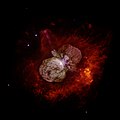Rikcha:Eta Carinae.jpg

Kay ñawpaq qhawariypa chhikan kaynin: 600 × 599 iñu. Huk huyakukuna: 240 × 240 iñu | 480 × 480 iñu | 769 × 768 iñu | 1025 × 1024 iñu | 2015 × 2013 iñu.
Qallariy willañiqi (2015 × 2013 iñu; willañiqip chhikan kaynin: 163 kB; MIME laya: image/jpeg)
Willañiqip wiñay kawsaynin
P'unchaw/pacha nisqapi ñit'iy chaypacha willañiqi kachkasqata qhawanaykipaq.
| P'unchaw/Pacha | Uchuylla rikchacha | Chhikanyachikuqkuna | Ruraq | Willapuy | |
|---|---|---|---|---|---|
| kunan | 09:41 18 dis 2017 |  | 2015 × 2013 (163 kB) | The NMI User | Reverted to version as of 14:14, 1 May 2008 (UTC) |
| 14:45 13 mar 2017 |  | 3000 × 2998 (1,18 MB) | Leogorgon | larger file size | |
| 14:14 1 may 2008 |  | 2015 × 2013 (163 kB) | Vol de nuit | {{Information |Description=(NASA News Release) A huge, billowing pair of gas and dust clouds are captured in this stunning NASA Hubble Space Telescope image of the supermassive star Eta Carinae. Using a combination of image processing techniques (ditheri |
Maypim willañiqita llamk'achinku
Kay rikchamanqa manam ima p'anqakunachu t'inkimun.
Mayqin wikikunapi willañiqita llamk'achinku
Kay wakin wikikunam willañiqitaqa llamk'achinku:
- da.wikipedia.org-pi kaykunapi llamk'achinku
- en.wikipedia.org-pi kaykunapi llamk'achinku
- Star
- Eta Carinae
- Wikipedia:Selected anniversaries/March 11
- Wikipedia:Today's featured article/March 2017
- Wikipedia:WikiProject Wikipack Africa Content/Wikipedia:Showcase
- Wikipedia:WikiProject WikiFundi Content/Eta Carinae
- Wikipedia:Today's featured article/requests/Eta Carinae
- Wikipedia:Today's featured article/March 12, 2017
- Wikipedia:Main Page history/2017 March 12
- Wikipedia:WikiProject WikiFundi Content/Wikipedia:Showcase
- Wikipedia:Main Page history/2022 March 11
- Wikipedia:Main Page history/2022 March 11b
- Wikipedia:Main Page history/2023 March 11
- Wikipedia:Main Page history/2023 March 11b
- User:2003 LN6/sandbox/Eta Carinae variable
- List of luminous blue variable stars
- en.wikiversity.org-pi kaykunapi llamk'achinku
- User:Marshallsumter/Radiation astronomy2/Visuals
- User:Marshallsumter/Radiation astronomy2/Violets
- Stars/Astronomy
- User:Marshallsumter/Radiation astronomy2/Violets/Quiz
- Stars/Sun/Astronomy/Quiz
- User:Marshallsumter/Radiation astronomy/Courses/Principles/Hourly 2
- User:Marshallsumter/Radiation astronomy/Courses/Principles/Final quiz
- Draft:Original research/Io/Quiz
- Titan/Quiz
- Stars/Solar systems/Quiz
- Moon/Quiz
- Earth/Quiz
- User:Marshallsumter/Radiation astronomy/Colors/Quiz
- Volcanoes/Io/Quiz
- Stars/Violets
- User:Marshallsumter/Radiation astronomy2/Stars
- Stars/Violets/Quiz
- es.wikipedia.org-pi kaykunapi llamk'achinku
- fr.wikipedia.org-pi kaykunapi llamk'achinku
- hi.wikipedia.org-pi kaykunapi llamk'achinku
- it.wikibooks.org-pi kaykunapi llamk'achinku
- la.wikipedia.org-pi kaykunapi llamk'achinku
- mk.wikipedia.org-pi kaykunapi llamk'achinku
- ms.wikipedia.org-pi kaykunapi llamk'achinku
- my.wikipedia.org-pi kaykunapi llamk'achinku
- oc.wikipedia.org-pi kaykunapi llamk'achinku
- ru.wikipedia.org-pi kaykunapi llamk'achinku
- sk.wikipedia.org-pi kaykunapi llamk'achinku
- sr.wikipedia.org-pi kaykunapi llamk'achinku
- th.wikipedia.org-pi kaykunapi llamk'achinku
Qhaway mayqin wikikunapim willañiqita llamk'achinku.
